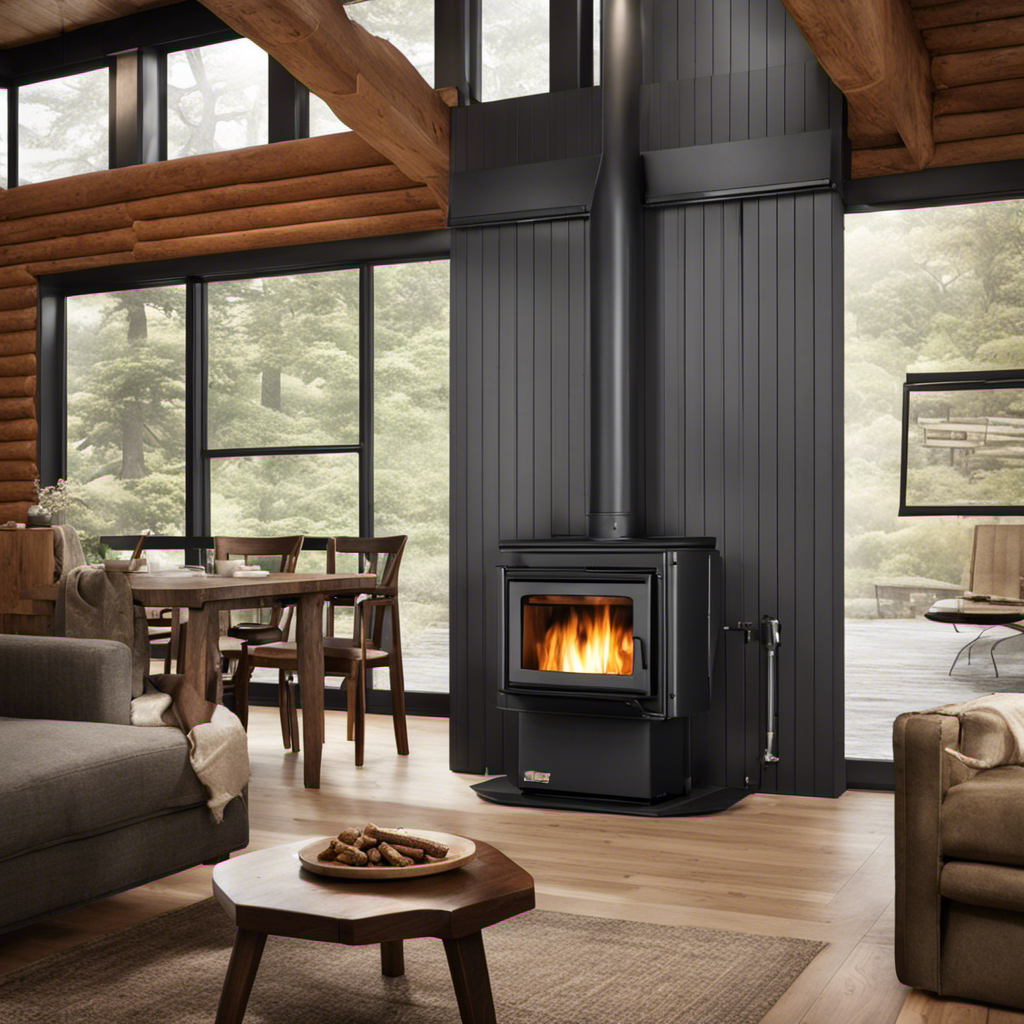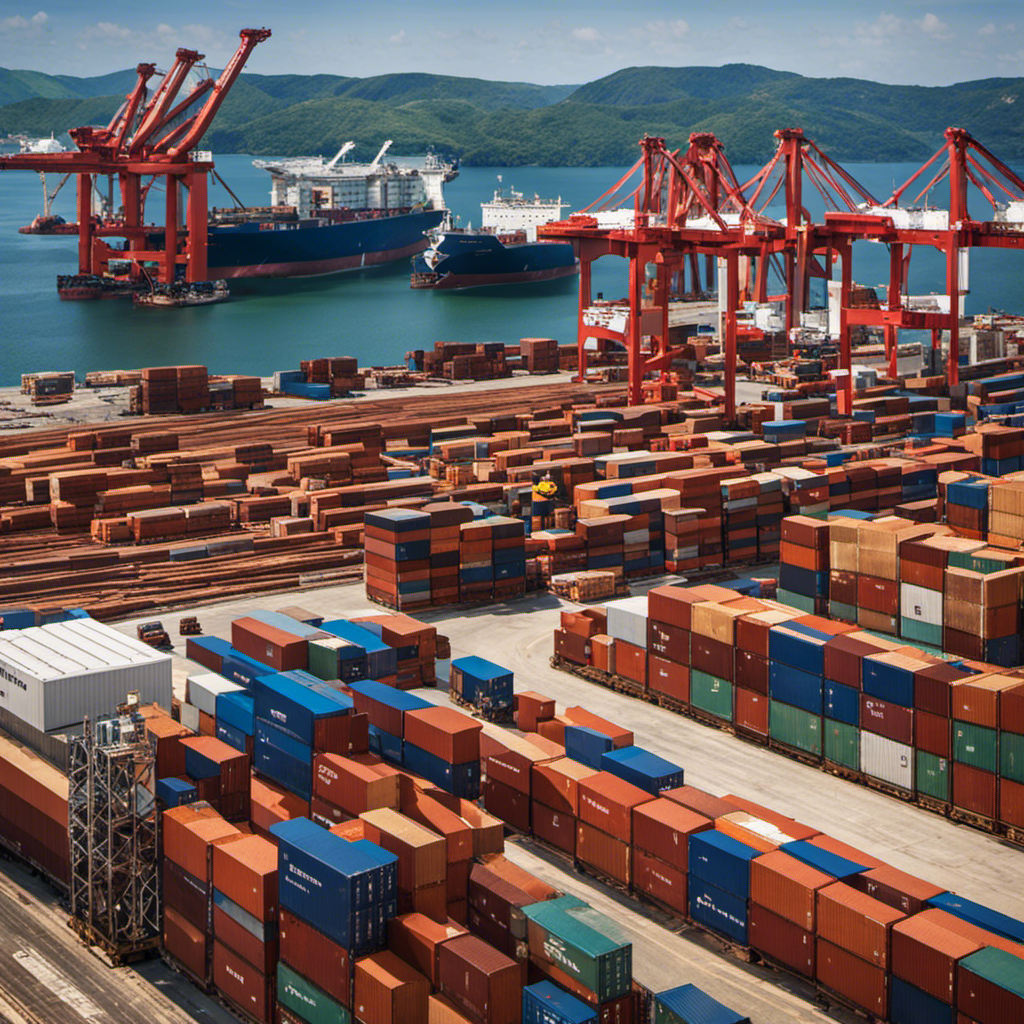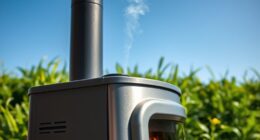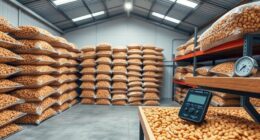As an owner of a wood pellet stove, I understand how crucial it is to regularly clean it to maintain its efficiency.
In this article, I’ll guide you through the step-by-step process of cleaning your wood pellet stove.
From removing and cleaning the burn pot and ash pan to maintaining the heat exchanger and cleaning the fan components, I’ll provide you with all the necessary tools, supplies, and techniques to ensure your stove stays in top condition.
Let’s dive in and discover the secrets to a clean and well-maintained wood pellet stove.
Key Takeaways
- Regular cleaning and maintenance of a wood pellet stove is important to prevent clogs, remove debris, and maintain optimal performance.
- Gathering the necessary tools and supplies, such as gloves, goggles, brushes, and cleaning solutions, is essential for effective cleaning.
- Following proper cleaning techniques, including turning off and allowing the stove to cool completely, cleaning the burn pot and ash pan, and brushing the venting system, ensures a thorough cleaning.
- Safety precautions, such as wearing protective gear, turning off the stove, and minimizing the risk of burns or fires, should be taken during the cleaning process.
Why Regular Cleaning Is Important
Regular cleaning is important because it helps prevent clogs and maintain optimal performance of your wood pellet stove. The importance of regular maintenance cannot be emphasized enough when it comes to wood pellet stoves. By cleaning your stove regularly, you can ensure that it operates efficiently and effectively.
Not only does regular cleaning prevent clogs from occurring, but it also helps to remove any built-up debris or ash that can hinder the stove’s performance. Cleaning your stove regularly also helps to extend its lifespan and reduce the risk of malfunctions. By taking the time to clean your wood pellet stove on a regular basis, you can enjoy the benefits of increased efficiency, reduced maintenance costs, and a longer-lasting appliance.
Now, let’s move on to gathering the necessary tools and supplies.
Gathering the Necessary Tools and Supplies
Before diving into the cleaning process, it’s important to gather the essential cleaning equipment. This includes gloves, goggles, brushes, and cleaning solutions. These tools will ensure that the cleaning process is efficient and thorough.
Additionally, it’s crucial to follow proper cleaning techniques to achieve the best results. This includes using the right cleaning motions and applying the appropriate amount of pressure.
Lastly, safety precautions should be considered at all times. This includes wearing protective gear, working in a well-ventilated area, and keeping cleaning solutions out of reach of children and pets.
Essential Cleaning Equipment
To effectively clean a wood pellet stove, you’ll need a few essential pieces of equipment.
First and foremost, you’ll need a quality ash vacuum specifically designed for pellet stoves. These vacuums have a high-temperature filter that can safely handle the fine ash produced by pellet stoves.
Additionally, a small brush with stiff bristles is essential for scrubbing away any stubborn debris or soot buildup.
I also recommend using a long, flexible brush to reach into the stove’s flue pipe and remove any creosote buildup.
Finally, a metal bucket or container is necessary to safely dispose of the ash.
These cleaning equipment recommendations are considered best practices for maintaining the efficiency and longevity of your wood pellet stove.
With the right tools in hand, let’s move on to the proper cleaning technique.
Proper Cleaning Technique
Once you have gathered the essential cleaning equipment, it’s important to start by turning off the stove and allowing it to cool completely. Cleaning a wood pellet stove requires proper technique to ensure safety and effectiveness. Here are the steps to follow:
-
Remove the ash: Using a specialized ash vacuum or a metal scoop, carefully remove the accumulated ash from the burn pot and the ash pan. Dispose of it in a metal container.
-
Clean the glass: Use a non-abrasive glass cleaner and a soft cloth to gently clean the glass window. Avoid using harsh chemicals or abrasive materials that could damage the glass.
-
Brush the venting system: Use a chimney brush to clean the venting system, removing any soot or debris that may have built up over time. This will ensure proper airflow and prevent blockages.
-
Wipe down the exterior: Use a damp cloth and mild soap to wipe down the exterior surfaces of the stove, removing any dust or dirt that may have accumulated.
By following these cleaning techniques and using the appropriate cleaning supplies, you can maintain a clean and efficient wood pellet stove.
However, it is important to also consider safety precautions to ensure a safe cleaning process.
Safety Precautions to Consider
For your own safety, remember to wear protective gloves and goggles while cleaning and ensure that the stove is completely turned off and cooled down. Safety measures and precautionary steps are essential when it comes to cleaning a wood pellet stove.
Before starting the cleaning process, it is important to take these precautions to prevent any accidents or injuries. Wearing protective gear such as gloves and goggles will shield your hands and eyes from chemicals and debris. Additionally, ensuring that the stove is turned off and cooled down will minimize the risk of burns or fires.
Step-by-Step Guide to Cleaning the Burn Pot
When it comes to maintaining the burn pot of your wood pellet stove, there are several key tips to keep in mind.
First and foremost, regular cleaning is essential to ensure optimal performance and prevent any potential issues.
Additionally, troubleshooting common problems that may arise with the burn pot can help you identify and resolve any issues quickly and efficiently.
Burn Pot Maintenance Tips
To keep your burn pot in good condition, you should regularly clean it to remove any ash buildup. Here are some burn pot maintenance tips to ensure optimal performance of your pellet stove:
-
Use a burn pot scraper: Gently scrape off any stubborn ash residue from the burn pot. Avoid using abrasive materials that may damage the surface.
-
Vacuum the burn pot: Use a shop-vac or a specially designed pellet stove vacuum to remove loose ash and debris from the burn pot. Make sure to wear protective gloves and a mask for safety.
-
Inspect the burn pot gasket: Check the condition of the gasket around the burn pot. If it is damaged or worn out, replace it to prevent air leaks and maintain proper combustion.
-
Clean the air intake holes: Use a small brush or a toothpick to clean the air intake holes in the burn pot. Blocked or clogged holes can disrupt airflow and affect pellet combustion.
Regular burn pot cleaning and maintenance are essential for the efficient operation of your pellet stove.
Now let’s move on to troubleshooting common issues that may arise.
Troubleshooting Common Issues
If your burn pot is not igniting properly, check the condition of the igniter and make sure it is functioning correctly. Troubleshooting common issues with wood pellet stoves can save you time and money.
One of the most common maintenance mistakes is neglecting to clean the burn pot regularly. A dirty burn pot can cause poor ignition and inefficient burning.
Another issue could be a clogged exhaust vent, which can lead to smoke buildup and poor performance. It is essential to inspect the vent and clean it if necessary.
Additionally, check the fuel quality and ensure that the pellets are not damp or contaminated. By troubleshooting these common issues, you can ensure that your wood pellet stove is working optimally.
Now, let’s move on to removing and cleaning the ash pan.
Removing and Cleaning the Ash Pan
First, empty the ash pan by carefully sliding it out from the bottom of the stove. It is important to regularly clean the ash pan to ensure proper functioning of your wood pellet stove. The frequency of cleaning will depend on how often you use the stove, but it is generally recommended to clean it at least once a week during peak usage.
Once the ash pan is removed, dispose of the ashes using appropriate methods. You can either bag them and dispose of them in your regular trash, or use them as fertilizer in your garden, as they are rich in nutrients.
Now that the ash pan is empty, we can move on to cleaning the exhaust vent and chimney, which is crucial for maintaining optimal performance of your wood pellet stove.
Cleaning the Exhaust Vent and Chimney
Once the ash pan is empty, you’ll want to focus on cleaning the exhaust vent and chimney to maintain optimal performance. It is crucial to regularly clean these components to ensure the efficient operation of your wood pellet stove.
Begin by inspecting the exhaust vent for any visible obstructions such as nests or debris. Use a chimney brush to remove soot and creosote buildup from the interior surfaces. Start from the bottom and work your way up, making sure to thoroughly clean the entire length of the vent.
Next, clean the chimney using the same method, ensuring that it is free from any blockages. A clean exhaust vent and chimney will promote better airflow and prevent any potential issues caused by buildup.
Now, let’s move on to clearing the auger and hopper of debris.
Clearing the Auger and Hopper of Debris
When it comes to maintaining a wood pellet stove, there are three key areas that require attention. These areas include removing clogged pellets, preventing blockages and jams, and cleaning the hopper.
To ensure optimal performance, it is crucial to address these aspects regularly. By following proper maintenance procedures, you can keep the stove running efficiently and avoid any potential issues that may arise from neglected pellet accumulation or blockages in the system.
Removing Clogged Pellets
To remove clogged pellets, you’ll need to carefully clear the blockage.
Start by turning off your wood pellet stove and allowing it to cool down completely. Then, open the hopper lid and remove any pellets that are easily accessible.
Next, use a long, flexible brush or a vacuum cleaner with a narrow attachment to reach inside the hopper and clear out any remaining pellets. Be sure to remove any debris or ash that may be blocking the pellet flow.
If the blockage persists, it may be necessary to disassemble the auger and clean it thoroughly. Troubleshooting tips include checking for any obstructions in the auger tube and making sure the auger motor is functioning properly.
By following these steps, you can effectively remove clogged pellets and ensure your wood pellet stove operates smoothly.
To prevent future blockages and jams, it is important to properly maintain your stove and regularly clean the hopper and auger system.
Preventing Blockages and Jams
Now that we have learned how to remove clogged pellets from a wood pellet stove, let’s discuss some preventive measures to avoid blockages and jams in the future. Troubleshooting issues can be time-consuming and frustrating, so it’s essential to take proactive steps.
Here are some tips to prevent blockages:
- Carefully inspect pellets for foreign objects or excessive dust before loading them into the hopper.
- Store pellets in a dry area to prevent moisture absorption, which can cause clumping and blockages.
- Regularly clean the hopper and remove any accumulated debris or ash.
- Ensure proper ventilation and airflow around the stove to prevent overheating, which can lead to pellet jams.
- Schedule regular maintenance and professional inspections to identify and address any potential issues before they become major problems.
By following these preventive measures, you can significantly reduce the likelihood of blockages and troubleshoot issues more effectively.
Now, let’s move on to cleaning the hopper.
Cleaning the Hopper
Make sure you empty out any leftover debris from the hopper regularly to maintain its cleanliness and prevent blockages. Cleaning the hopper is an essential part of wood pellet stove maintenance.
To do this, start by turning off the stove and allowing it to cool down completely. Next, remove the hopper lid and use a small brush or vacuum cleaner to remove any ash or dust that has accumulated inside. Pay close attention to the corners and edges where debris can easily collect.
Once the hopper is clean, replace the lid and ensure it is securely fastened.
Now, let’s move on to cleaning the glass door and viewing window, which is crucial for maintaining proper airflow and ensuring a clear view of the flames.
Cleaning the Glass Door and Viewing Window
You’ll want to start by gathering the necessary supplies for cleaning the glass door and viewing window of your wood pellet stove. To clean the gasket seal, you’ll need a soft cloth, mild detergent, and warm water. Gently wipe down the gasket seal, making sure to remove any dirt or debris that may have accumulated.
Next, focus on removing soot buildup from the glass door and viewing window. Use a glass cleaner specifically designed for wood stoves, as other cleaners may cause damage. Spray the cleaner onto the glass and let it sit for a few minutes to loosen the soot. Then, carefully scrub the glass with a non-abrasive sponge or cloth. Rinse with clean water and dry with a lint-free cloth.
Now, let’s move on to maintaining and cleaning the heat exchanger.
Maintaining and Cleaning the Heat Exchanger
To keep the heat exchanger of your wood pellet stove running efficiently, it’s important to regularly maintain and clean it. Proper heat exchanger maintenance is crucial for optimal performance and to prevent any potential issues. Here are some key steps to follow:
- Inspect the heat exchanger for any signs of damage or corrosion.
- Clean the heat exchanger using a soft brush or vacuum to remove any accumulated dust and debris.
- Check the gaskets and seals for any wear or leaks, and replace them if necessary.
- Ensure that the airflow through the heat exchanger is unobstructed by removing any obstacles.
- If you encounter any issues with the heat exchanger, such as reduced heat output or unusual noises, troubleshoot the problem by checking the fuel supply, air intake, and exhaust systems.
By regularly maintaining and troubleshooting heat exchanger issues, you can ensure that your wood pellet stove operates efficiently and effectively.
Now, let’s move on to cleaning the fan and blower components.
Cleaning the Fan and Blower Components
To effectively maintain the fan and blower components, it’s important to regularly inspect and remove any accumulated dust or debris. These components play a crucial role in ensuring proper airflow and heat distribution in your wood pellet stove. Neglecting their maintenance can lead to reduced performance and potential damage.
Cleaning the ashtray is a simple but essential step in maintaining the fan and blower system. This will prevent any blockage or restriction in airflow caused by ash buildup. Additionally, the fan motor should be regularly checked and cleaned to ensure smooth operation. A dirty or clogged motor can lead to overheating and potential breakdown.
By regularly cleaning these components, you can ensure optimal performance and prolong the lifespan of your wood pellet stove.
Properly storing and maintaining your wood pellet stove is crucial to its longevity and efficiency.
Properly Storing and Maintaining Your Wood Pellet Stove
When storing and maintaining your wood pellet stove, remember to regularly inspect and clean the ashtray and fan components.
Proper storage techniques are essential to ensure the longevity and efficiency of your stove. Before storing the stove, make sure to remove all the pellets from the hopper and clean out any remaining ash.
It is also important to disconnect the stove from the power source and clean the fan blades to remove any dust or debris. Additionally, it is recommended to cover the stove with a waterproof cover to protect it from moisture and dust during storage.
Following a maintenance schedule will help prevent any issues and ensure that your wood pellet stove is ready to use when needed.
Frequently Asked Questions
How Often Should I Clean My Wood Pellet Stove?
I clean my wood pellet stove regularly to maintain its efficiency. It’s important to clean the ash pan and glass door to remove any build-up. Regular cleaning ensures optimal performance and extends the lifespan of the stove.
Can I Use Regular Household Cleaning Products to Clean My Stove?
I can’t believe how easy it is to clean a wood pellet stove! There are alternative cleaning methods that don’t require regular household cleaning products. It’s important to use eco-friendly products for a greener home.
What Safety Precautions Should I Take When Cleaning My Wood Pellet Stove?
When cleaning my wood pellet stove, I ensure safety by following best practices. This includes wearing protective gear, turning off the stove, and allowing it to cool down before beginning maintenance.
How Can I Tell if My Exhaust Vent and Chimney Need Cleaning?
I can easily tell if my exhaust vent and chimney need cleaning by looking for signs like reduced airflow, increased smoke, and a strong odor. Regular maintenance and proper pellet quality can prevent build-up in these areas.
Are There Any Specific Maintenance Tasks I Should Perform on My Wood Pellet Stove to Keep It Running Efficiently?
Maintenance tips for wood pellet stove efficiency include regular cleaning of ash and debris, checking and replacing gaskets, inspecting and cleaning the exhaust vent and chimney, and ensuring proper fuel quality. A troubleshooting guide can help identify and resolve issues promptly.
Conclusion
In conclusion, keeping your wood pellet stove clean is essential for its efficient and safe operation. By regularly cleaning the burn pot, ash pan, exhaust vent, chimney, glass door, and heat exchanger, you can ensure that your stove functions optimally and produces clean heat.
Additionally, maintaining the fan and blower components is crucial for proper airflow and distribution of warm air. So, why settle for a dirty stove when a little cleaning can make a big difference in its performance and longevity?
Logan’s affair with adventure began in childhood. He hailed from a small town where vast forests bordered one side and endless shores stretched on the other. His days were spent exploring uncharted woods, climbing tall trees, or listening to the tales of old sailors. This early immersion in a world brimming with stories and mysteries became the foundation of his passion for writing.











